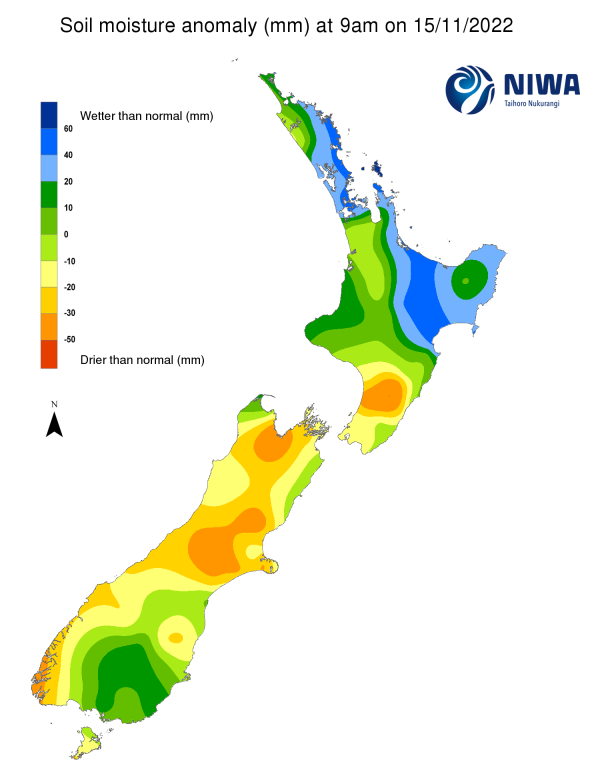A weekly update describing soil moisture patterns across the country to show where dry to extremely dry conditions are occurring or imminent. Regions experiencing significant soil moisture deficits are deemed “hotspots”. Persistent hotspot regions have the potential to develop into drought.
Facts: soil moisture
In the North Island, heavy rain was observed in many northern and eastern areas during the past week. In eastern Northland, the Coromandel Peninsula, Bay of Plenty, Gisborne, and northern Hawke’s Bay, many locations saw rainfall totals exceed 100 mm, with isolated areas receiving near 200 mm. More moderate amounts of 25 mm or less were observed in the Far North, western Waikato, and the lower North Island. This resulted in substantial soil moisture increases in the aforementioned regions in the upper and eastern North Island, while soil moisture levels did not change significantly in western and southern portions of the island. The driest soils across the North Island, when compared to normal for this time of the year, are found in southern Manawatū-Whanganui, while the wettest soils for this time of the year are found in eastern Northland, Auckland, and from central Bay of Plenty to Hawke’s Bay.
No hotspots are currently located in the North Island.
In the South Island, rainfall amounts were meagre in the West Coast, Otago, and Southland, where most locations received 10 mm or less. Amounts were slightly higher in the top of the island and in northern Canterbury, where pockets of rainfall reached 20-30 mm. This resulted in moderate soil moisture decreases across the entire island, with the most significant decreases taking place in the West Coast, Otago, and Southland. The driest soils in the South Island, when compared to normal for this time of the year, are located in Nelson, central Canterbury, and coastal Fiordland, while the wettest soils for this time of the year are found in interior Otago and Southland.
In the past week, an existing hotspot in central Canterbury continued to expand, now covering parts of Hurunui, coastal Waimakariri, Selwyn, and Ashburton districts. As of 13 November, the New Zealand Drought Index (NZDI) map below shows that dry and very dry conditions are located in portions of central Canterbury.
Outlook and soil moisture
In the North Island, unsettled weather is expected over the next week as nearly daily showers and thunderstorms are likely to occur in many areas, particularly in northern and central portions of the island. Some of these showers and storms will be very slow-moving while producing locally heavy rainfall and the potential for localised flooding. The most widespread and organised rainfall is likely to occur on Friday (18 November) as a front moves from north to south across the island. Weekly rainfall totals will be highly localised depending on where exactly the heaviest showers and thunderstorms occur, but it appears that some locations in the Central Plateau could see totals near or in excess of 200 mm. Elsewhere across the northern and western North Island, amounts nearing 100 mm may occur. Rainfall totals may be somewhat lower along the east coast however.
Due to the expected rainfall in the next week, substantial soil moisture increases are likely in large swaths of the North Island, although only slight changes may occur along the east coast. No hotspots are expected to form in the North Island in the next week.
In the South Island, afternoon showers and isolated thunderstorms may affect interior areas on Wednesday and Thursday (16-17 November) before more substantial rain reaches northern and central areas from late Friday through Saturday (18-19 November). After more afternoon showers on Sunday, several waves of heavier rain will impact the West Coast from Monday through Wednesday (21-23 November). Weekly rainfall totals may reach or exceed 150 mm in parts of the West Coast, with 50 mm or more possible in Tasman, Nelson, and Marlborough Sounds. However, the east coast and lower South Island may receive less than 40 mm.
Due to the expected rainfall in the next week, soil moisture levels will likely increase in the West Coast and most of the upper South Island, with slight increases possible along the east coast. Little change is expected in Otago and Southland. The existing hotspot in central Canterbury may weaken slightly in the next week, but it is unlikely to dissipate. No other hotspots are expected to form in the South Island.
Background
Hotspot Watch: a weekly advisory service for New Zealand media. It provides soil moisture and precipitation measurements around the country to help assess whether extremely dry conditions are imminent.
Soil moisture deficit: the amount of water needed to bring the soil moisture content back to field capacity, which is the maximum amount of water the soil can hold.
Soil moisture anomaly: the difference between the historical normal soil moisture deficit (or surplus) for a given time of year and actual soil moisture deficits.
Definitions: “Extremely” and “severely” dry soils are based on a combination of the current soil moisture status and the difference from normal soil moisture (see soil moisture maps).
Hotspot: A hotspot is declared if soils are "severely drier than normal" which occurs when Soil Moisture Deficit (SMD) is less than -110 mm AND the Soil Moisture Anomaly is less than -20 mm.


Soil moisture anomaly maps, relative to this time of year. The maps show soil moisture anomaly for the past two weeks. [NIWA]
As of 13 November, the New Zealand Drought Index (NZDI) map below shows that dry and very dry conditions are located in portions of central Canterbury. Please note: some hotspots in the text above may not correspond with the NZDI map. This difference exists because the NZDI uses additional dryness indices, including one which integrates the rainfall deficit over the past 60 days. Changes are therefore slower to appear in the NZDI compared to soil moisture anomaly maps that are instantaneously updated.


